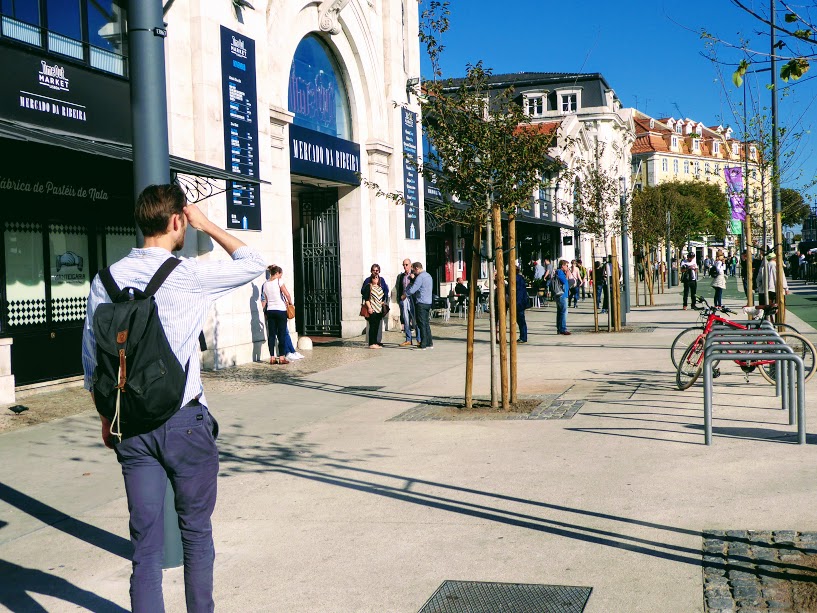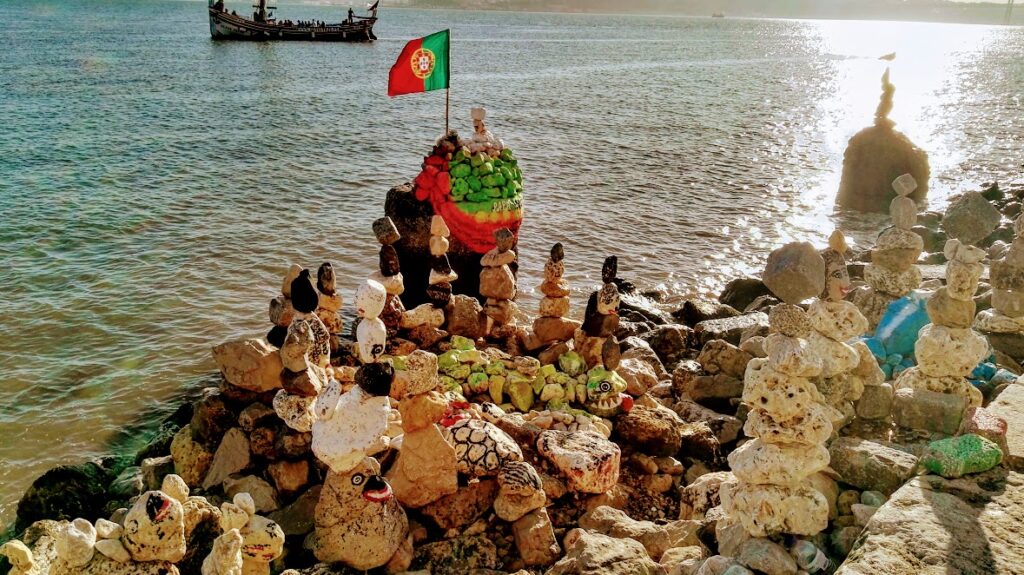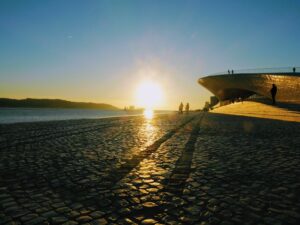Brand Lisboa – Exploring Dynamic Urban Renewal
On the 14th November 2017 both the Llanelli and London offices of The means were left empty as the company embarked on its away day to Lisbon. Since the economic crisis of 2008, Portugal’s capital has been on a remarkable journey of place branding and marketing, leading to it becoming one of Europe’s premier locations for start-ups and innovative technologies. No clearer indication of this was there than the decision by Web Summit to host their annual event in Lisbon for 3 years from 2016 to 2018. Many European cities are looking to recreate the late 1990s success story of Barcelona in rebuilding the city into a forward facing new economy, however, only so many can achieve this. During our trip we sought to unpick how Lisbon’s historical attributes were being utilised to create a strong place brand that lures in the investment and talent for an urban renaissance.
After arriving at our hotel via metro, a metro system which like in Melbourne, New York, Madrid and Paris has mobile reception, we dined out in style at Barrio do Avillez. The brainchild of Michelin star winning chef Jose Avillez, this was the physical embodiment of Lisbon blending the old and the new, the traditional and novel, the parochial pride and desire for international recognition. Located in Chiado, amongst the most expensive real estate in Portugal, an entire building has been divided into 5 culinary experiences ranging from a rustic taberna for traditional meats and cheese, to an upmarket patio restaurant for luxury seafood dishes. Beyond the excellent quality of the food and locally sourced wines, was the quality of the welcome our staff gave us. It is expected that in high profile restaurants customer facing employees speak English, but the degree of fluency was a pleasant surprise to the extent that the South London, Carmarthenshire or Birmingham accents showcased by The means team posed no obstacle to our dedicated waiters. This was a recurring theme throughout the trip. In other European holiday destinations the quality of English can be lacking or non-existent. While it is arguably presumptuous to assume that other nationalities should cater to British monoglot needs, it is the reality for many English speaking tourists.

Futhermore, 51% of internet content is in English; to put that in context Russia is the second most common language with 7%. For Lisbon to be as accessible and attractive to tourists and global entrepreneurs alike, urban regeneration begins in the language classroom. Whether on a tram, buying pottery or browsing a bookshop, there was someone capable of providing perfect English assistance to us.
Our trip was divided between urban exploration, and honing our place making approach through morning study sessions. Amongst the team, we were each given a place of interest to read up on and analyse in terms of its role in contributing to the brand of Lisbon. Of particular interest were the histories of Pasteis de Belem, the LX Factory, Time Out Market, and the Museum of Art, Architecture and Technology (MAAT). For a city to be a 21st Century trendsetter, reliable infrastructure and workspace is essential, but not enough on its own. A growing trend in urbanism is marketing a city as not just the location of attractive jobs but the starting point for a desirable lifestyle. Postcard perfect sites either screaming modernity and style, or celebrating unique heritage, are tried and tested tool for this. The essence or culture of a city is often only understood in terms of a handful of memorable places or items. This is where Lisbon is currently excelling.
Even before we had left the airport we had seen the famous pasteis de nata for sale in a café, it was almost impossible to enter a café throughout the city and not see them on offer. So symbolic of Lisbon are the custard tarts that visitors flock to Pasteis de Belem, a 200 year old confectionery set up by dispelled monks, to see and taste what is regarded as the original and best incarnation of the treat. While foods are strongly associated with other places around the world, few rival the strength of the connection between Lisbon and the pasteis de nata. Crepes and croissants are strongly associated with France, but no particular town or city is known as the birthplace. Pizza is often traced to Naples in Italy, but so widely reproduced and in a myriad of forms that its brand is somewhat diluted. This led our group to reflect on what the U.K’s equivalent to pasteis de nata would be, what the British public would suggest and would foreign commentators would say? The success of Lisbon’s desert of choice lies in its relatively easy reproduction, distinctive appearance and great flavour. When seen in any English bakery or shop, the brand of Lisbon is reinforced and distributed, keeping the city at the front of people’s mind. This isn’t urban regeneration with bricks and mortar, but eggs and sugar instead.

Similarly, the LX Factory and Time Out Market showcase urban renewal without any cement being mixed. While cities like Hong Kong, Tbilisi and Dublin are growing vertically through steel and glass spectres of modernity, Lisbon is repurposing existing buildings, giving them a facelift, and grabbing the headlines. Since 1892 the Mercado da Ribeira with its exposed industrial iron trusses and oriental dome, was the main food market of Lisbon. In 2014 Time Out magazine took over the market aiming to capture all of Lisbon under one roof. Time Out magazine or website is often the first stop for anyone looking to make the most of their city experience with exhaustive listings of restaurants, bars, nightclubs, music venues and theatres. The fact that they chose Lisbon as the home of their first market in Europe shows the increasing perceived value of Portugal’s capital. When we visited on a Wednesday it was a hive of activity, both tourists and locals indulging in the wide range of Portuguese delicacies. Enjoyable as the market was, the uneasy question loomed over our minds as place makers; if this model is exported around the world, will it truly champion local cultures or homogenise the concept of a market resulting in a monoculture. Later in the day we saw the LX Factory equally busy. The offer here is more diverse and geared towards a younger audience. Described as a “hipster paradise”, this previously industrial works now houses live jazz, rooftop bars, designer clothes shops, workspaces for media and communication services, an escape room and even a pole dancing school. The ultimate playground for creative professionals and a great advert for the city. Considering that Lisbon has seen its population plummet over the past 40 years from 800,000 in 1981 to 500,000 today, this is an impressive feat showing a resilience from the city’s inhabitants and investors. There is an atmosphere of vitality that seems to be enough to convince young entrepreneurs to relocate, Lisbon has over 300,000 enterprises with more than 25,000 of these appearing in 2016.
 We ended our final day together as a company watching the sun set into the Tagus from the roof of the recently completed MAAT, a not to be missed opportunity according to the various online guides to the city we had read in preparation. A similar attempt at revitalizing a city through the installation of new cultural institute showcasing cutting edge architecture has occurred elsewhere on the Iberian Peninsula to mixed reviews. The Guggenheim Museum in Bilbao, while visually impressive is argued to be incongruous with its surroundings and lacking in local sensitivity. Sometimes, successful cities need a bit of luck. Transplanting an opera house or art gallery into a post-industrial landscape can often seem a contrived or blinkered attempt to stimulate new cultural activities. In the case of Lisbon, with the foundations of welcoming dynamic people, rich cultural history, and the stunning natural scenery of an estuary valley, the conditions are there for an urban renaissance, the build element of a city is often the final piece of the puzzle.
We ended our final day together as a company watching the sun set into the Tagus from the roof of the recently completed MAAT, a not to be missed opportunity according to the various online guides to the city we had read in preparation. A similar attempt at revitalizing a city through the installation of new cultural institute showcasing cutting edge architecture has occurred elsewhere on the Iberian Peninsula to mixed reviews. The Guggenheim Museum in Bilbao, while visually impressive is argued to be incongruous with its surroundings and lacking in local sensitivity. Sometimes, successful cities need a bit of luck. Transplanting an opera house or art gallery into a post-industrial landscape can often seem a contrived or blinkered attempt to stimulate new cultural activities. In the case of Lisbon, with the foundations of welcoming dynamic people, rich cultural history, and the stunning natural scenery of an estuary valley, the conditions are there for an urban renaissance, the build element of a city is often the final piece of the puzzle.
